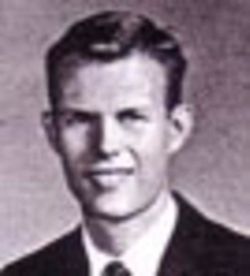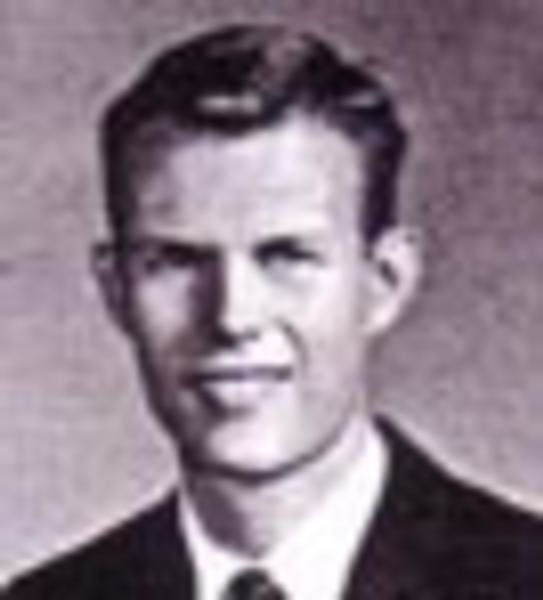View cenotaph HERE.
~
William Thomas Carter
December 4, 1941
US Navy
Lieutenant Junior Grade
7th Fleet, Vs 21, TF 77, USS Kearsarge
MIA Status
Declared Dead while Missing
Death November 10, 1966
North Vietnam, Long An province.
Died through Non-Hostile action, air crash at sea, Body not recovered
Lieutenant Junior Grade Carter, U.S. Naval Reserve, was a member of Air Anti-Submarine Squadron 21 aboard the aircraft carrier USS KEARSARGE (CVS-33). On November 10, 1966, he was a crew member of a Martin Tracker Anti-Submarine Aircraft (S-2E) over the Gulf of Tonkin when contact with the aircraft was lost. His remains were not recovered.
He had graduated from Clemson University with the class of 1964. He majored in biology.
------------------
1966, there were several search and rescue (SAR) destroyers parked off the coast of North Vietnam in the Gulf of Tonkin. When the attack and fighter people would egress, they would be there to assist a cripple or pick up a guy who had to punch out or ditch.
During the night when the strike activity would ebb, the SAR DDs would steam around their small areas waiting for the next day's activities. It was during these night and early
morning hours that high speed surface contacts would probe their positions.
The "Stoof" (S2) helped provide air cover for these surface ships, as well as utilize electronic technical gear to pinpoint locations of enemy activity.
As antisubmarine warfare was all but unknown in Vietnam, there were a variety of duties handled by those trained in antisubmarine warfare. As marking submarines, and/or destroying them involved the use of marking buoys, electronic "ears" and other technical equipment suited for target marking, antisubmarine teams were frequently used for search missions. They also sometimes assisted in attacks on small enemy water craft.
The Stoof (also called "Tracker") was technically an anti-submarine aircraft, but had
other missions in Vietnam. There were only a few of such planes assigned to Vietnam at all.
For example, if a ship thought its position was being probed by enemy boats, it might vector the Stoof out over the target. The Stoof tactic was to drop a parachute retarded flare from about 10,000 feet over the target, circle back around at a low altitude (about 300 feet) and investigate. If the target was unfriendly, then the S2 would engage and destroy it. There was a certain amount of risk involved in these operations, as the Vietnamese PT boats had radar that enabled them to strike with no visual contact.
In the dead of night, at 10:30 p.m. on November 10, 1966, an S2E launched from the USS Kearsarge with pilot LT Thomas J. McAteer, and crewmembers LTJG William T. Carter, AX3 John M. Riordan, and AX3 Eric J. Schoderer. (AX designates Antisubmarine warfare technicians and related duties). Their mission was a surveillance flight in the Gulf of Tonkin.
McAteer's Tracker was last in radar contact with the control ship at 1:45 a.m. It was not uncommon to lose periodic radar contact with a Tracker when it dived below radar to investigate a surface target. But when the Tracker did not return to the ship at their expected time, a search and rescue effort was begun. The search produced aircraft wreckage and personal survival and flight gear, but no survivors.
The cause of the crash of McAteer's aircraft was not determined. It was suspected that the aircraft made an uncontrolled contact with the water. The aircraft was determined lost about 55 miles east-northeast of the city of Hue in the Gulf of Tonkin. The crew status was initially Missing in Action, but was changed the following day to Killed/Body Not Recovered.
When considering a personnel loss at sea, the criteria for survival involves both the location and the cause of the loss. In the case of the S2E, no reason for loss was ever determined. Therefore, it was either shot down or went down due to mechanical difficulties or "pilot error."
If mechanical difficulties resulted in the downing of the S2E, in an entirely non-hostile environment, then there can be little chance of survival for the crew of the S2E unless they managed to cross 50 miles of ocean. If enemy activity was present, however, there can be ample room for speculation that the crew might have been captured.
The crew of the S2E is among nearly 3000 Americans who remained prisoner, missing, or otherwise unaccounted for at the end of the Vietnam war. Since that time, cases have been resolved by the return of remains and by other means. Since the end of the war, nearly 10,000 reports relating to these Americans have been received by the U.S. Government, convincing many authorities that hundreds of Americans remain alive in enemy hands today.
Whether the crew of the S2E survived to be captured can only be speculated. It would be kinder to them and to their families if they died on November 10, 1966. It is impossible to imagine the agony they must feel to have been abandoned by their country. It is heartbreaking to consider that Americans still await rescue by the country they proudly served.
View cenotaph HERE.
~
William Thomas Carter
December 4, 1941
US Navy
Lieutenant Junior Grade
7th Fleet, Vs 21, TF 77, USS Kearsarge
MIA Status
Declared Dead while Missing
Death November 10, 1966
North Vietnam, Long An province.
Died through Non-Hostile action, air crash at sea, Body not recovered
Lieutenant Junior Grade Carter, U.S. Naval Reserve, was a member of Air Anti-Submarine Squadron 21 aboard the aircraft carrier USS KEARSARGE (CVS-33). On November 10, 1966, he was a crew member of a Martin Tracker Anti-Submarine Aircraft (S-2E) over the Gulf of Tonkin when contact with the aircraft was lost. His remains were not recovered.
He had graduated from Clemson University with the class of 1964. He majored in biology.
------------------
1966, there were several search and rescue (SAR) destroyers parked off the coast of North Vietnam in the Gulf of Tonkin. When the attack and fighter people would egress, they would be there to assist a cripple or pick up a guy who had to punch out or ditch.
During the night when the strike activity would ebb, the SAR DDs would steam around their small areas waiting for the next day's activities. It was during these night and early
morning hours that high speed surface contacts would probe their positions.
The "Stoof" (S2) helped provide air cover for these surface ships, as well as utilize electronic technical gear to pinpoint locations of enemy activity.
As antisubmarine warfare was all but unknown in Vietnam, there were a variety of duties handled by those trained in antisubmarine warfare. As marking submarines, and/or destroying them involved the use of marking buoys, electronic "ears" and other technical equipment suited for target marking, antisubmarine teams were frequently used for search missions. They also sometimes assisted in attacks on small enemy water craft.
The Stoof (also called "Tracker") was technically an anti-submarine aircraft, but had
other missions in Vietnam. There were only a few of such planes assigned to Vietnam at all.
For example, if a ship thought its position was being probed by enemy boats, it might vector the Stoof out over the target. The Stoof tactic was to drop a parachute retarded flare from about 10,000 feet over the target, circle back around at a low altitude (about 300 feet) and investigate. If the target was unfriendly, then the S2 would engage and destroy it. There was a certain amount of risk involved in these operations, as the Vietnamese PT boats had radar that enabled them to strike with no visual contact.
In the dead of night, at 10:30 p.m. on November 10, 1966, an S2E launched from the USS Kearsarge with pilot LT Thomas J. McAteer, and crewmembers LTJG William T. Carter, AX3 John M. Riordan, and AX3 Eric J. Schoderer. (AX designates Antisubmarine warfare technicians and related duties). Their mission was a surveillance flight in the Gulf of Tonkin.
McAteer's Tracker was last in radar contact with the control ship at 1:45 a.m. It was not uncommon to lose periodic radar contact with a Tracker when it dived below radar to investigate a surface target. But when the Tracker did not return to the ship at their expected time, a search and rescue effort was begun. The search produced aircraft wreckage and personal survival and flight gear, but no survivors.
The cause of the crash of McAteer's aircraft was not determined. It was suspected that the aircraft made an uncontrolled contact with the water. The aircraft was determined lost about 55 miles east-northeast of the city of Hue in the Gulf of Tonkin. The crew status was initially Missing in Action, but was changed the following day to Killed/Body Not Recovered.
When considering a personnel loss at sea, the criteria for survival involves both the location and the cause of the loss. In the case of the S2E, no reason for loss was ever determined. Therefore, it was either shot down or went down due to mechanical difficulties or "pilot error."
If mechanical difficulties resulted in the downing of the S2E, in an entirely non-hostile environment, then there can be little chance of survival for the crew of the S2E unless they managed to cross 50 miles of ocean. If enemy activity was present, however, there can be ample room for speculation that the crew might have been captured.
The crew of the S2E is among nearly 3000 Americans who remained prisoner, missing, or otherwise unaccounted for at the end of the Vietnam war. Since that time, cases have been resolved by the return of remains and by other means. Since the end of the war, nearly 10,000 reports relating to these Americans have been received by the U.S. Government, convincing many authorities that hundreds of Americans remain alive in enemy hands today.
Whether the crew of the S2E survived to be captured can only be speculated. It would be kinder to them and to their families if they died on November 10, 1966. It is impossible to imagine the agony they must feel to have been abandoned by their country. It is heartbreaking to consider that Americans still await rescue by the country they proudly served.
Sponsored by Ancestry
Advertisement
Records on Ancestry
Sponsored by Ancestry
Advertisement



